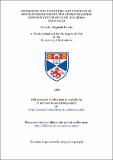Files in this item
Studies on the structure and function of mechanoreceptors in the stomatogastric nervous system of some decapoda crustacea
Item metadata
| dc.contributor.advisor | Laverack, M. S. | |
| dc.contributor.author | Dando, Malcolm Reginald | |
| dc.coverage.spatial | 127 p. | en_US |
| dc.date.accessioned | 2018-07-04T09:16:46Z | |
| dc.date.available | 2018-07-04T09:16:46Z | |
| dc.date.issued | 1969 | |
| dc.identifier.uri | https://hdl.handle.net/10023/14896 | |
| dc.description.abstract | i. The stomatogastric nervous system of some of the decapod crustacea contains several small isolated ganglia. At least one of these ganglia is useful for the detailed investigation of the generation of a patterned central output controlling movement. A review of previous work shows that little is known of the anatomy and physiology of the sense organs innervating the foregut. This knowledge would be valuable for understanding the control mechanisms governing the foregut function because reflex mechanisms are probable important in this situation. Therefore the aim of the thesis was to investigate the mechanoreceptors innervating the foregut. Work was concentrated on these sense organs because they are probably involved directly in the control of movement. ii. The large amount of previous work on this type of sense organ in the higher decapods is summarised in an appendix. An attempt is also revise to some of the terminology used in the study oi these receptors, and recent developments are reviewed in some detail. iii. Two new major receptor systems innervating the foregut are described. The posterior stomach (p.s.n.) contains a group of about 80 neurones which innervate the posterior of the gastric mill. These neurons respond to normal movements of the mill. Changes in the input from the receptors affect the output from the stomatogastric ganglion. The other system (MPRs) consists of three distinct organs totalling about 40 neurones which monitor normal movements of the structures around the mouth iv. Suggestions are made top further specific work on these two receptor systems. What is now known of the sensory innervation of the foregut is summarised and suggestions made for completing this knowledge. v. Further possible work on the ganglia and the role the associated mechanoreceptor organs is reviewed. Finally work on other problems related to the studies reported here is discussed. | en_US |
| dc.language.iso | en | en_US |
| dc.publisher | University of St Andrews | |
| dc.subject.lcc | QP151.D2 | |
| dc.subject.lcsh | Stomach | en |
| dc.title | Studies on the structure and function of mechanoreceptors in the stomatogastric nervous system of some decapoda crustacea | en_US |
| dc.type | Thesis | en_US |
| dc.type.qualificationlevel | Doctoral | en_US |
| dc.type.qualificationname | PhD Doctor of Philosophy | en_US |
| dc.publisher.institution | The University of St Andrews | en_US |
This item appears in the following Collection(s)
Items in the St Andrews Research Repository are protected by copyright, with all rights reserved, unless otherwise indicated.

